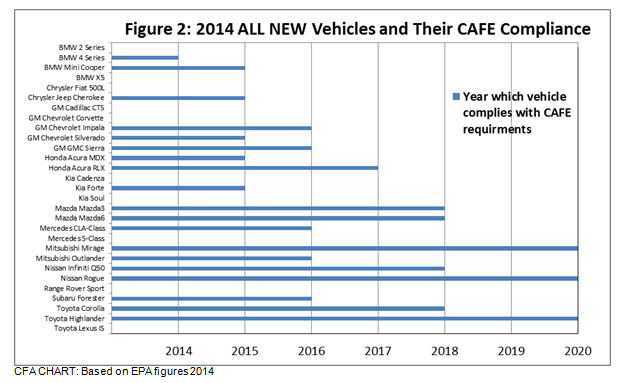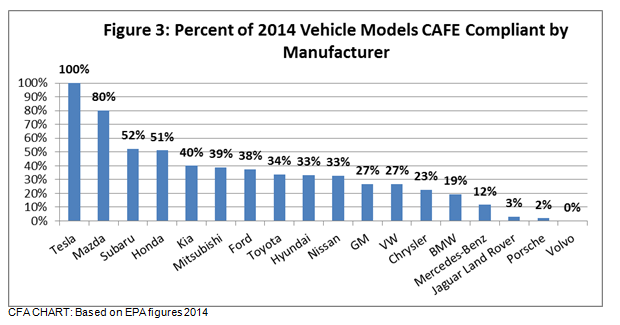Washington, D.C. – The nation’s passenger vehicle marketplace is in the midst of a major transformation according to new research undertaken by the Consumer Federation of America (CFA). More than ever before consumers are purchasing, and planning to purchase, vehicles with increased fuel economy. Car manufacturers, in the meantime, are making improvements both to meet this demand and to comply with new federal standards.
From 2008 to 2014, the average fuel economy of new cars increased by 20 percent from 21 miles per gallon (mpg) to 25.6 mpg. As Figure 1 shows, in 2014, a consumer who drives a typical 2014 new car model will spend almost $300 less for gasoline than someone who drives a typical 2008 new car model (assuming both drove 15,000 miles this year, and in spite of the fact that gasoline was somewhat less expensive in 2008).

These savings are likely to increase in the coming years because more than ever, as consumers plan to substantially increase the fuel economy of their next vehicle purchase compared to their current vehicle. According to a recent survey by ORC[1] International of more than 1000 representative adult Americans, drivers expect a median of 30 mpg in their next vehicle purchase. At current gas prices ($3.56), the increase of over four mpg (25.6 mpg to 30 mpg) would save the typical driver more than $300 in the first year and thousands over the lifetime of the vehicle, compared to new vehicles purchased in 2014 (if the consumer drives 15,000 miles annually).[2]
The ORC survey also revealed that more than four-fifths of those surveyed (83 percent) support (with 56 percent “strongly” supporting) the current federal fuel economy standards of 54.5 mpg by 2025. Support for the current fuel economy standards cuts across partisan lines, with 76 percent of Republicans, 83 percent of Independents and 89 percent of Democrats favoring the standards.
“Consumers want and expect the vehicles they intend to purchase to get significantly higher fuel economy,” noted CFA’s director of research, Mark Cooper. “Many Americans struggle to live within their budgets, and a large majority are troubled about future gasoline prices,” he added. In the ORC survey, 80 percent of those surveyed said that “in thinking about the next five years,” they were “concerned” about gasoline prices with 64 percent indicating “great” concern.
Car Manufacturers On the Road to 54.5 MPG, With Some Standouts
“Car manufacturers are well on their way to meet the 2025 fuel economy standards,” said Jack Gillis, CFA’s director of public affairs and author of The Car Book. “Because the new federal standards are in line with consumer demand, carmakers understand that meeting those standards is one of the best ways to ensure market success in the future,” said Gillis.
Of the 29 truly new vehicles introduced in 2014, 19 have a model that is compliant with 2014 requirements, 13 are compliant with 2016 standards and seven meet 2018 standards (Figure 2). Of the all-new 2014 models, 3 are actually compliant with 2020 standards (Mitsubishi Mirage, Nissan Rogue, and Toyota Highlander).

Overall, in 2014, Mazda, Subaru, and Honda stand out as having the highest percentage of models compliant with 2014 standards among manufacturers with multiple vehicle models[3] (Figure 3). Eighty percent of Mazda models, 52 percent of Subaru models, and 51 percent of Honda models met the 2014 requirements.[4]

“Meeting consumer demand, ensuring market success, increasing America’s energy independence and protecting the environment are all coming together with the 2025 fuel economy standards,” said Gillis.
Note 1: Gasoline consumption is based on driving 15,000 miles per year at the average mileage for new cars of that model year. 15,000 miles per year is the standard assumption used by EPA and NHTSA. Expenditures are calculated by multiplying the number of gallons of gasoline consumed by the average prices of gasoline in a given year. The gasoline price for 2020 is assumed to be equal to the average price of gasoline in 2014. We use 2008 as the base year because that was the year in which the first increase in CAFE standards was proposed under the approach mandated by the Energy Independence and Security Act of 2007.
Contact: Jack Gillis, 202-737-0766
CFA is an association of more than 250 nonprofit consumer groups that was founded in 1968 to advance the consumer interest through research, advocacy, and education.
[1] The ORC International survey was commissioned by CFA and conducted May 1-4, 2014 by landline and cellphone. Its margin of error is plus or minus three percentage points.
[2] This analysis assumes the 30 mpg expected mileage is for new vehicles. Using an alternative assumption that the 30 mpg is for all vehicles purchased suggests much larger pocketbook savings. Respondents say that the mileage for all their current vehicles is 24 mpg, which his close to the national average (most recent data from EIA put the average in 2012 at 23.3 mpg). If the analysis is conducted assuming 24 mpg for the average vehicle and 18,200 miles per household (the average based on the most recent Consumer Expenditure Survey, household gasoline consumption would decline from the current average of 759 gallon to 606 gallons and household gasoline expenditures would decline from $2,715 to $2,172.
[3] Telsa, with only one all electric vehicle had 100% compliance with 2014 requirements.
[4] Actual compliance with any year’s CAFE requirements will not be officially determined until all model year sales are reported to the government and final calculations are made. This can take 2-3 years after the model year. In addition, because compliance is based on sales weighted averages, manufacturers can have models that do not comply, as long as their overall average is compliant. The more vehicles they sell that meet the standard, the more likely they will fully comply.

